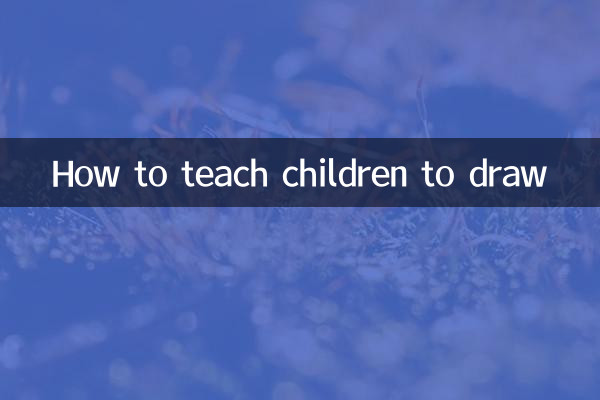How to teach children’s drawing: 10 days of hot topics and structured teaching guide
In today's era of information explosion, children's art education has become a hot topic for parents and teachers. The following are hot topics and structured data on children's painting teaching across the Internet in the past 10 days to help you master scientific teaching methods.
1. Trend analysis of hot topics

| Ranking | Topic keywords | search volume index | associated age |
|---|---|---|---|
| 1 | Creative art enlightenment | 58,200 | 3-6 years old |
| 2 | Digital painting teaching | 42,500 | 7-12 years old |
| 3 | Parent-child painting interaction | 36,800 | 3-10 years old |
| 4 | Psychological Analysis of Painting | 29,400 | All ages |
| 5 | Environmentally friendly materials used | 25,100 | 4-8 years old |
2. Detailed explanation of age-specific teaching method
According to research on child development psychology, differentiated teaching strategies are needed for different age groups:
| age group | Teaching focus | Tool recommendation | Lesson suggestions |
|---|---|---|---|
| 3-4 years old | Doodle exploration | Thick crayons/finger paints | 15 minutes/time |
| 5-6 years old | shape recognition | Watercolor brushes/clay | 20 minutes/time |
| 7-8 years old | scene building | Markers/Collage Materials | 30 minutes/time |
| 9-10 years old | Perspective Basics | Colored lead/digital tablet | 45 minutes/time |
3. Evaluation of hot teaching tools
The TOP5 drawing tools and their teaching suitability that have been hotly discussed among parents recently:
| Tool name | Security level | Difficulty of cleaning | creativity index |
|---|---|---|---|
| water soluble crayons | ★★★★★ | ★★ | ★★★★ |
| washable paint | ★★★★ | ★★★★ | ★★★★★ |
| Magnetic drawing board | ★★★★★ | ★ | ★★★ |
| 3D painting pen | ★★★ | ★★★ | ★★★★★ |
| sand painting table | ★★★★ | ★★★★ | ★★★★ |
4. Teaching process optimization plan
Based on the advice of education experts, the following structured teaching process is recommended:
1.interest arousing stage(5 minutes): Creating situations through story/music
2.Free exploration stage(15 minutes): Provide a variety of materials to try independently
3.Skills guidance stage(10 minutes): Demonstration of key painting techniques
4.creative expression stage(20 minutes): Complete the theme work
5.Share evaluation stage(10 minutes): Use the "sandwich feedback method" (affirmation + suggestion + encouragement)
5. Solutions to common problems
| Problem phenomenon | Cause analysis | coping strategies |
|---|---|---|
| refuse to hold pen | Insufficient hand muscle development | Use finger paint/sponge stamps instead |
| The picture is messy | Spatial perception is not formed | Provide drawing paper for different areas |
| excessive imitation | lack of observation training | Carry out physical sketching games |
| single color | The color sensitivity period has not yet arrived | Use contrasting materials |
6. Important reminders for parents to assist
1. Avoid ghostwriting and maintain the originality of your works
2. Change painting materials regularly to keep them fresh (it is recommended to update them every 2-3 months)
3. Establish a work portfolio to record the growth trajectory
4. Participate in art museum study activities to broaden your aesthetic horizons
Through the above structured teaching system, it can not only cultivate children's artistic expression ability, but also promote cognitive development, emotional management and creative thinking. It is recommended to practice regularly 2-3 times a week and start the journey of artistic enlightenment in a relaxed and pleasant atmosphere.

check the details

check the details